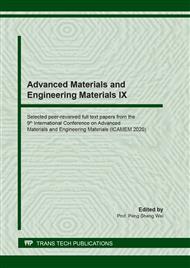[1]
Hashmi, S., Comprehensive materials finishing, Elsevier. (2016).
Google Scholar
[2]
Long, B.T., et al., Optimization of PMEDM process parameter for maximizing material removal rate by Taguchi's method, The International Journal of Advanced Manufacturing Technology. 87(5-8) (2016) 1929-1939.
DOI: 10.1007/s00170-016-8586-4
Google Scholar
[3]
Das, M., et al., Optimization of surface roughness and MRR in EDM using WPCA, Procedia Engineering. 64 (2013) 446-455.
DOI: 10.1016/j.proeng.2013.09.118
Google Scholar
[4]
Tsai, H., B. Yan, and F. Huang, EDM performance of Cr/Cu-based composite electrodes. International Journal of Machine Tools and Manufacture, 43(3) (2003) 245-252.
DOI: 10.1016/s0890-6955(02)00238-9
Google Scholar
[5]
Lajis, M.A., H. Radzi, and A. Amin, The implementation of Taguchi method on EDM process of tungsten carbide, European Journal of Scientific Research. 26(4) (2009) 609-617.
Google Scholar
[6]
Luis, C., I. Puertas, and Villa, Material removal rate and electrode wear study on the EDM of silicon carbide, Journal of materials processing technology. 164 (2005) 889-896.
DOI: 10.1016/j.jmatprotec.2005.02.045
Google Scholar
[7]
Zarepour, H., et al., Statistical analysis on electrode wear in EDM of tool steel DIN 1.2714 used in forging dies, Journal of Materials Processing Technology. 187 (2007) 711-714.
DOI: 10.1016/j.jmatprotec.2006.11.202
Google Scholar
[8]
Shunmugam, M., P. Philip, and A. Gangadhar, Improvement of wear resistance by EDM with tungsten carbide P/M electrode, Wear. 171(1-2) (1994) 1-5.
DOI: 10.1016/0043-1648(94)90340-9
Google Scholar
[9]
Marafona, J., Black layer characterisation and electrode wear ratio in electrical discharge machining (EDM), Journal of Materials Processing Technology. 184(1-3) (2007) 27-31.
DOI: 10.1016/j.jmatprotec.2006.10.045
Google Scholar
[10]
Huo, J., et al., Influence of process factors on surface measures on electrical discharge machined stainless steel using TOPSIS. Materials Research Express. 6(8) (2019).
DOI: 10.1088/2053-1591/ab1ae0
Google Scholar
[11]
Hoang, T.T., et al., Modelling Surface Finish in Electrical Discharge Machining Tablet Shape Punches using Response Surface Methodology (Thiếu thông tin bài báo: tên tạp chí, năm, số, trang).
DOI: 10.17265/2162-5263/2017.07.006
Google Scholar
[12]
Le Xuan Hung, T.T.H. and V.N. Pi, A Study on Modelling Surface Finish in Electrical Discharge Machining Tablet Shape Punches Using Response Surface Methodology. Journal of Environmental Science and Engineering B 6 (2017) 387-390.
DOI: 10.17265/2162-5263/2017.07.006
Google Scholar
[13]
Jabbaripour, B., et al., Investigating surface roughness, material removal rate and corrosion resistance in PMEDM of γ-TiAl intermetallic, Journal of Manufacturing Processe. 15(1) 2013 56-68.
DOI: 10.1016/j.jmapro.2012.09.016
Google Scholar
[14]
Tripathy, S. and D. Tripathy, An approach for increasing the micro-hardness in electrical discharge machining by adding conductive powder to the dielectric, Materials Today: Proceedings. 4(2) (2017) 1215-1224.
DOI: 10.1016/j.matpr.2017.01.140
Google Scholar
[15]
Kung, K.-Y., J.-T. Horng, and K.-T. Chiang, Material removal rate and electrode wear ratio study on the powder mixed electrical discharge machining of cobalt-bonded tungsten carbide, The International Journal of Advanced Manufacturing Technology. 40(1-2) (2009) 95-104.
DOI: 10.1007/s00170-007-1307-2
Google Scholar


